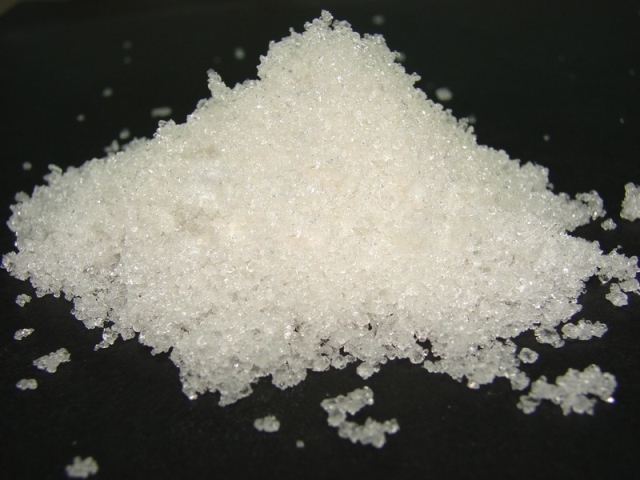Calcium nitrate is a chemical that can fertilize plants. In agriculture, it is usually referred to as calcium nitrate. There are other names for this substance: calcium nitrate, calcium nitrate, calcined or Norwegian. Used also in construction and other industries. Next, let's talk about the properties and application.
Table of contents
The composition and release form of calcium nitrate
Calcium nitrate belongs to the category of nitrogen mineral fertilizers. The composition is as follows. The amount of valuable substances varies from different manufacturers. Approximate indicators: nitrogen - 15% (from 11.6%), calcium - from 16 to 19%.
This drug is packaged in Russia by different companies. The retail garden stores and small wholesale bases most often include the brands “Bui fertilizers” (packaging of 1 kg, 25 g, 20 g), Fertika (1 kg). RThe guaranteed shelf life is usually indicated in the range of 1-2 years, but the shelf life of such chemicals does not imply certain limitations (in sealed packaging).
The substance is highly soluble in water (especially in warm). Available in the form of snow-white rounded granules or crystals (like salt, sugar). The granular form is more convenient - it absorbs moisture from the air less. The crystals must be stored strictly in a sealed package, otherwise they quickly dampen, bleed, slyaty.
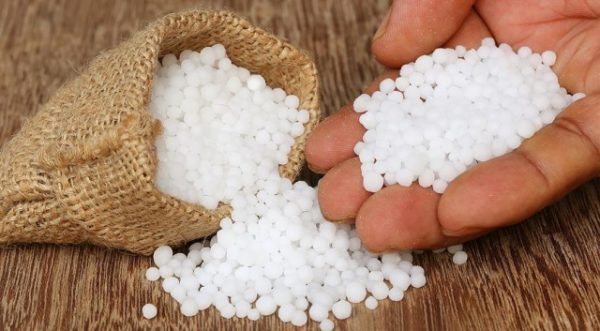
The value of the complex of nitrogen and calcium
Nitrogen is the most important element in plant nutrition. But it is poorly absorbed with increased acidity of the soil. Many nitrogen fertilizers (urea, ammonium nitrate) acidify the substrate. Calcium nitrate manifests itself otherwise. It is important combination, the interaction of the two components.
Most cultivated plants do not like high acidity. Calcium nitrate neutralizes or reduces it. The role of calcium in the life of the soil and plants is multifaceted. This item:
- promotes the development of beneficial soil microorganisms, which improves the structure of the soil;
- neutralizes harmful salts and metals, blocks their entry into plants;
- stimulates the germination of tubers, bulbs and seeds in the soil;
- activates the growth of root hairs;
- strengthens the cell membranes of plants, helping to resist attacks of diseases and pests;
- improves nitrogen absorption and other metabolic processes, chlorophyll synthesis;
- helps the movement of carbohydrates, increasing the sugar content and other nutritional qualities of fruits, seeds;
- increases storage capacity and crop transportability.
Regular fertilization with calcium nitrate on acidic soils reduces the incidence of top rot (tomatoes and peppers), keeled (cabbage, radish); give bright color to fruits (apples, etc.).
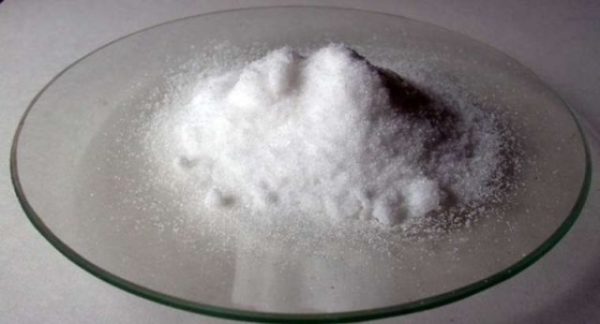
Restrictions on cultures
No need to treat calcium nitrate lovers of sour soil:
- hvoyniki, ferns
- hydrangea
- rhododendron, azalea
- heather
- blueberry, cranberry, lingonberry
Cultures that prefer a slightly increased acidity of the soil solution do not need this substance:
- honeysuckle, barberry, viburnum
- acacia, maple (decorative)
- lupine, chamomile, poppy
Plants responsive to the use of calcium nitrate
The drug is appropriate to use for those crops that are the most productive (decorative) on soils close to neutral. The effect is especially noticeable in plants carrying a lot of nutrients - with abundant green mass or a large load of fruits. Main list:
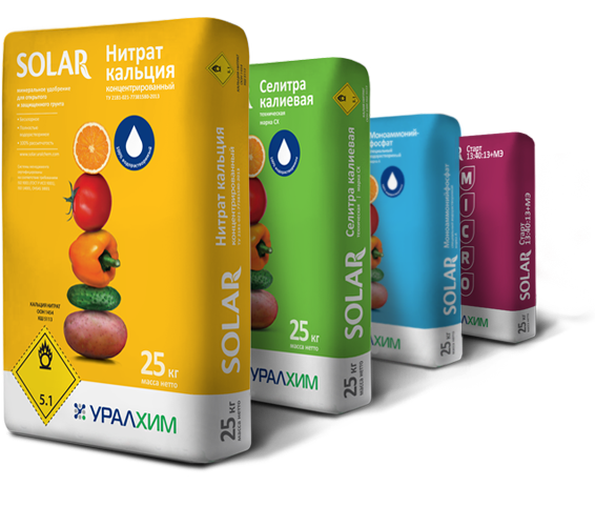
Vegetables
- cucumbers, zucchini, pumpkins, watermelons, melons
- tomatoes, peppers, eggplants
- potatoes
- cabbage
- salad and other greens
- peas, beans
- onion garlic
Fruit and berry
- strawberry
- stone fruits (cherry, plum, etc.)
- grapes
- Apple tree
Dekorativka
- clematis
- lilies (tubular, LO and OT-hybrids)
- phlox
- dahlias
- gladioli, spring bulbous
- petunia
- lawn
Fertilization
Soil type
- It is not recommended to use calcium nitrate in alkaline lands.
- The most effective application on subacid and acidic soils.
- The gardens and vegetable gardens located on sod-podzolic soils respond well to calcium nitrate. This is a territory of mixed forests and forest-steppes on the East European and West Siberian plains.
- On heavy clays and loams they feed less often, on light sandy loams - gradually, but more often.
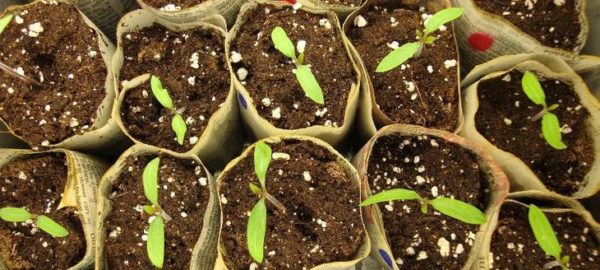
Terms, methods and dosage
- When spring plowing plantations, digging beds are made dry granules - from 1 to 2.5 kg per 10 square meters. This method is rarely used - if there is no organic matter.
- Dry fertilizer poured into the wells in the spring before planting. Especially useful for cabbage, tomatoes, peppers on acidic soil (1 teaspoon per well).
- Fertilizer seasonal irrigation: 20 g of the drug is dissolved in 10 liters of water, spent on 10 square meters of landings. Under a bush, a young tree, 2-3 liters of solution are poured at a time, under an adult tree - near a bucket.
- Cherry, plum, apple, grapes, ornamental shrubs, perennial flowers - 1 time in spring before bud break or at the beginning of the growing season.
- Lilies - 1 time: at regrowth of shoots to a height of 10 cm.
- Strawberries, strawberries - after the snow melted and in early August.
- Seedlings (tomatoes, peppers, cucumbers, cabbage, celery, flowers) - 1 time in 2 weeks.
- Cucumbers, zucchini - repeatedly, every 7-14 days (according to needs).
- Onions, garlic, lettuce, celery, potatoes, tomatoes, beans, peas, petunia, siderats - 1-2 times in the stage of growing greens.
- Lawn - 3 times, every 30 days (from mid-April to mid-summer). Dosage 400 grams per 10 square meters.
- Foliar feedings
- allow you to quickly deliver food to plant tissues
- especially useful in cool or hot weather (when the flow through the roots decreases)
- needed on acidic soils for the prevention of disease (rot of tomatoes and peppers, bitter pitting apples)
- increase the nutritional value of the fruit, prolong its capacity, improve its color (apples, tomatoes, etc.)
- give splendor to decorative and deciduous plants, improve the presentation of seedlings
Solution: 20-30 g of fertilizer per 10 liters of water. Spraying tomatoes, peppers, cucumbers, cherries, plums, grapes, and apple trees are produced two to four times per season (for early greenery, at the budding stage, at the onset of fruit formation). Spend 1.5-2 liters per 10 square meters of planting or on a large bush, half a bucket on a tree.
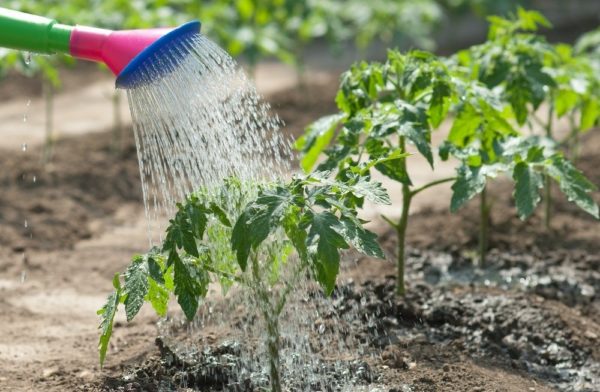
Additional rules
When working with calcium nitrate, the same principles apply as with other nitrogen fertilizers:
- Liquid root dressings are given to perennial crops only in the first half of summer, otherwise their winter hardiness decreases.
- It makes no sense to fill the land with nitrate during the autumn digging: before the next season, nitrogen flushing will occur.
- Do not feed the "fattening" plants with signs of excess nitrogen.
- Do not exceed the dose.
The consequences of overdose:
- “Fattening” the green mass to the detriment of fruiting
- burns of plants and soil
- excess nitrates in foods
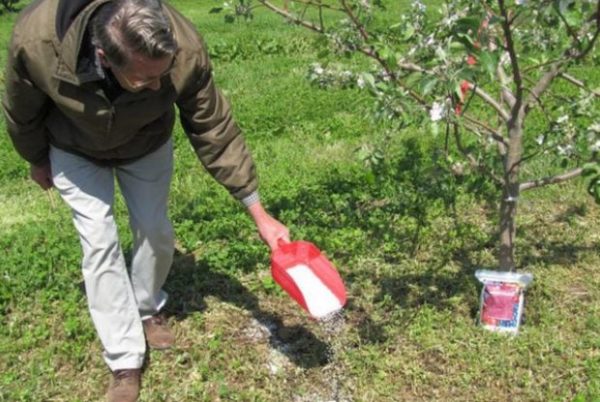
Alternative application
Calcium nitrate solution (60 g per 10 l of water) is moistened with fresh sawdust to make them faster. A similar mixture (only the concentration of fertilizer is made half as much) is taken as a substrate for the forcing of tulips.
Compatibility
Experienced gardeners are advised not to mix calcium nitrate with any other drugs at all - neither in a dry nor in a dissolved state.

It is strongly NOT recommended to connect with:
- other nitrogen fertilizers (both mineral and organic)
- humates
- superphosphate
- potassium chloride
- lime substances
- stimulants, pesticides
Allowed dry mixing of granules with phosphate rock, potassium sulfate, ash - just before entering into the soil.
Precautionary measures
Store calcium nitrate must be in a sealed original packaging. The open pack should be kept in a dry room, used for six months.
Substance belongs to the III class of danger. This means that with standard use it is not dangerous to humans and the environment.Strong concentrations can cause burns to the skin and mucous membranes. All actions with fertilizer must be done carefully, in work clothes and rubber gloves. If the chemical comes into contact with the skin and into the eyes, rinse with running water, if crystalline dust is inhaled, wash the mucous membranes, if accidentally swallowed, drink a large amount of water, take activated charcoal and consult a doctor.
Information about the explosion of calcium nitrate is very controversial. Fertilizer manufacturer Buysky Chemical Plant calls the substance “explosion-proof and non-flammable,” according to the State Technical Supervision Authority. However, the research team of "InfoMine" warns that with a strong shaking or impact, the chemical can ignite with an explosion (like ammonium nitrate).
Cargo carriers note: calcium nitrate practically does not ignite when ignited, but when heated and blows it can decompose with an explosion and a flame, releasing toxins. It is recommended to keep the fertilizer away from any other substances, from organic matter, away from fire. The fire is extinguished by a very large amount of water. The compacted fertilizer mass is not split by blows, but dissolved.
Calcium nitrate is a valuable nitrogenous fertilizer for gardeners and farmers, farms and peasant farms. Its use is especially beneficial on land with high acidity. Improved nutrition and stimulation of immunity are observed in those plants that prefer a less acidic soil solution.
